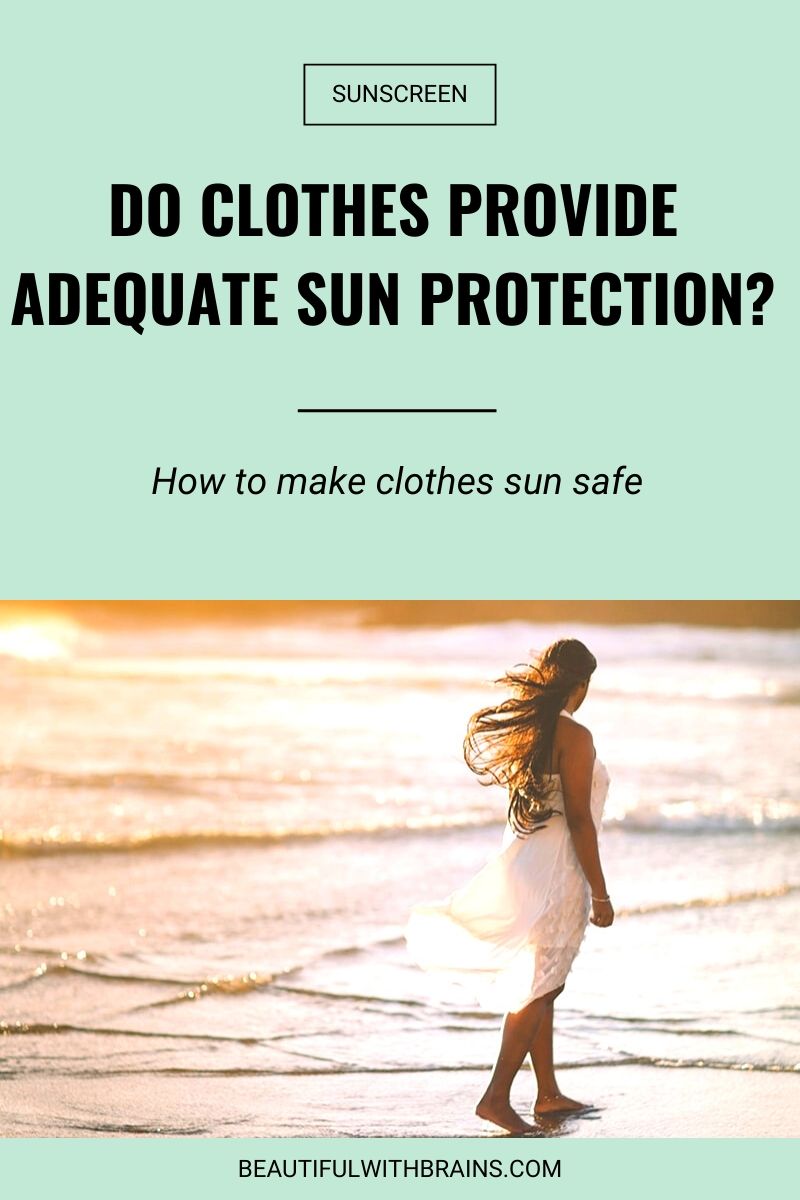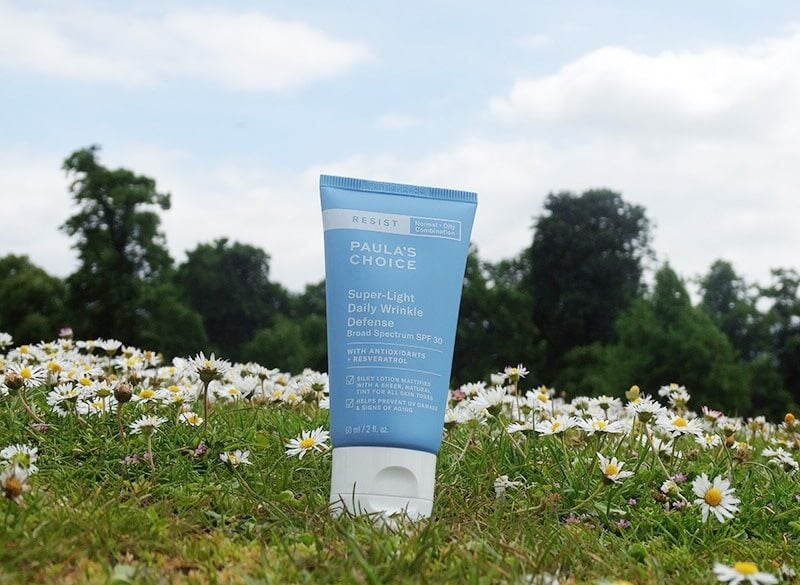
Hands up if you never apply sunscreen under your clothes.
“What’s the point?,” I hear you ask. “The sun can’t get through your clothes, right?”
Wrong. Those cute sundresses you’re living in during the summer months are no match for UV rays. They get right through them.
But, not all clothes are created equal. Some do provide adequate sun protection – even sans sunscreen. Others need a helping hand to keep you safe from UV harm.
It’s easier than you think. Here’s how to make your clothes sun safe:
What Is UPF?
UPF stands for Ultraviolet Protection Factor. It’s basically the SPF for clothing. It describes how many UV rays can get through their threads and reach your skin.
According to the ARPANSA (Australian Radiation Protection And Nuclear Safety Agency), here’s how different levels of UPF protect your skin from UV harm.
| UPF RATING | PROTECTION CATEGORY | % UV RAYS BLOCKED |
|---|---|---|
| 15, 20 | Good | 93.3 – 95.9 |
| 25, 30, 35 | Very good | 96.0 – 97.4 |
| 40, 45, 50, 50+ | Excellent | 97.5> |
PRO TIP: For maximum protection, look for fabrics with an UPF of at least 30.
Related: Take A Number: What Level Of SPF Do You Really Need?
How Is UPF Different From SPF?
UPF may be the SPF for clothing, but they don’t exactly work in the same way.
For starters, they measure different things. UPF tells you the amount of UV rays that penetrates through your clothes and hits your skin. SPF tells you how many more UV rays you can receive before you get a sunburn.
If you burn after 20 minutes in the sun, SPF 15 will protect your skin 15 times longer. That’s in a lab. In real life, things are a little different. For example, you’ll probably rub or sweat off your sunscreen within a couple of hours. Sunscreen can’t protect you 15 times longer if it’s not on your skin.
The other main difference? UPF measures protection from both UVA and UVB rays. SPF only from UVB rays.
Related: What’s The Difference Between UVA and UVB Rays?
How effective is your sunscreen? Sign up to the newsletter below to receive the “Sunscreen Audit” Worksheet and find out if your sunscreen is really up to the job:
What Clothes Provide Adequate Sun Protection?
That cute white crop top may look amazing in summer, but don’t fool yourself it’ll protect you from UV harm. For reference, an average white t-shirt has a UPF of only 5!
What should you wear instead? Turns out, the clothes that provide the best sun protection are usually the ones you don’t want to wear in the heat of summer… Typical, isn’t it?
Here’s what makes clothes sun safe:
- Colour: Dark and bright colours absorb more UV rays, keeping them from reaching your skin. Choose black over white or bright red over a pastel pink.
- Thickness: Tightly woven fabrics like denim or wool provide more protection that sheer or loosely woven fabrics. If you can see through a piece of clothing when you hold it up to the light, it won’t provide adequate sun protection.
- Fit: Tight clothes can stretch overtime, reducing the level of protection they provide. Opt for loose clothing when possible.
- Coverage: The more skin your clothes cover, the better. No explanation necessary.
- Composition: Shiny fabrics deflect more UV rays than matte fabrics. Unbleached cotton contains natural lignins that absorb UV rays. Fabrics treated with UV absorbers or dyes provide some sun protection, too.
WARNING! It doesn’t matter how high the UPF of your clothes is, if they get wet or stretch too much, they’ll become useless.
How To Make Your Clothes Sun Safe
I know what you’re thinking: “Gio, I don’t want to spend my summer in thick black clothes that make me sweat like a pig. I want to rock my thin sundresses and white, flowing skirts.”
Good news: you can. Here’s how to make ALL clothes sun safe:
1. Wear UPF Protective Clothing
The easiest way to make your clothes sun safe? Buy clothes that come with their own in-built UPF. Look for pieces that have a UPF of 30 and higher.
Unfortunately, most brands that make UPF protective clothing care more about effectiveness than style. I don’t know about you, but I don’t want to look dowdy ever. Not even to avoid sun damage.
I like Coolibar and Solbari. Their clothes have a SPF 50+ and are more fashionable than their competitors. The best part? You don’t have to reapply sunscreen (on the covered areas, that is).
Related: Do You Really Need To Reapply Sunscreen Every 2 Hours?
2. Wash Your Regular Clothes With Sun Guard®
If you’re anything like me, you don’t want to buy a whole new summer wardrobe. Especially if you don’t dig the style of UPF clothing…
What if I told you there’s a way to add sun protection to your regular, every day clothes? Enter Sun Guard®. It’s a laundry aid with UV filter Tinosorb® FD that adds sun protection in your clothes as you wash them.
Studies show that “a single treatment of Rit Sun Guard sustains a UPF of 30 for approximately 20 launderings.” Impressive, isn’t it?

3. Apply Sunscreen All Over Your Body
If you can’t be bothered with UPF clothing and just want to wear what you want when you want (*raises hand*), simply apply your sunscreen all over your body before getting dressed.
It doesn’t matter if you’re wearing a long, flowy skirt or a long-sleeved top, apply sunscreen underneath to be on the safe side.
Sure, reapplication is a little tricky, but even just one generous application in the morning is better than no sunscreen at all.
Best Picks:
- EltaMD UV Pure Broad-Spectrum SPF 47 ($25.00): Available at Dermstore and Walmart
- La Roche Posay Anthelios Clear Skin Dry Touch Sunscreen Broad Spectrum SPF 60 ($19.99): Available at Blue Mercury, Dermstore and Ulta
- Paula’s Choice Super-Light Wrinkle Defense SPF 30 ($33.00): Available at Dermstore, Feel Unique, Nordstrom and Paula’s Choice
Related: Are You Applying Sunscreen The Right Way?
The Bottom Line
Most clothes don’t provide adequate sun protection. Unless you’re willing to invest in clothes with a UPF of 30 or higher or have access to Sun Guard®, you need to apply sunscreen all over your body.

